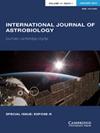脱水薄膜介质快速估算生物负荷,实现行星保护飞行
IF 1
4区 物理与天体物理
Q3 ASTRONOMY & ASTROPHYSICS
引用次数: 0
摘要
行星保护(PP)是保护太阳系天体免受地球生物污染和保护地球免受潜在有害的外星生物污染的实践。在地球上,用棉签和湿巾对洁净室和航天器表面进行分析,然后在80°C下加热15分钟,以选择孢子。以胰酶大豆琼脂(TSA)为生长培养基,采用倒板法和皮氏板(TSA板)对样品进行进一步处理。这种采样和处理程序被称为NASA标准分析(NSA),被世界各地的PP工程师使用。近年来,美国国家安全局越来越多地采用最先进的技术,如膜过滤,并推动将环保技术应用于日常活动。脱水薄膜介质,如石化膜快速好氧计数(RAC)板,适合这些目标,作为TSA板的替代方法。由于在培养基中加入了显色指示剂,RAC板比TSA板显示细菌生长(并区分菌落和外来颗粒,如气泡)更快。RAC板的环境足迹也比TSA板小得多,并且设计用于评估甚至一些难以检测的环境生物,包括在几个小时内填满超过25%的板面积的扩散器。考虑到这些好处,NASA喷气推进实验室的PP小组承担了在NSA背景下直接比较RAC板和TSA板的任务。RAC板不仅能够检测表面环境样品和相当于nsa处理过的TSA板的体外加标样品,而且在RAC板上可以计数到传播菌,其培养密度比TSA板高10到100倍。此外,RAC板在加入膜过滤器时表现出强大的线性检测能力,并且很容易从RAC板上获得生物体用于存档或后处理实验,包括MALDI-TOF细菌鉴定。RAC板具有易于使用,占地面积小,快速准确的生物负荷测量,具有克服当前PP培养方案所带来的限制的潜力。本文章由计算机程序翻译,如有差异,请以英文原文为准。
Dehydrated thin film media to rapidly estimate bioburden for planetary protection flight implementation
Planetary Protection (PP) is the practice of safeguarding solar system bodies from terrestrial biological contamination and screening the Earth against potentially harmful extraterrestrial biological contamination. On Earth, cleanrooms and spacecraft surfaces are assayed using swabs and wipes that are then heat shocked for 15 min at 80°C to select for spores. The samples are further processed using the pour-plate method and Petri plates (TSA plates), with trypticase soy agar (TSA) serving as the growth medium. This sampling and processing procedure, called the NASA Standard Assay (NSA), is used by PP engineers around the world. Recent years have seen an increase in the incorporation of state-of-the-art technology, such as membrane filtration, into the NSA, with a push for implementing environmentally friendly technology into day-to-day activities. Dehydrated thin film media, such as Petrifilm Rapid Aerobic Count (RAC) plates, suit these goals as an alternative method to TSA plates. RAC plates show bacterial growth (and distinguish colonies from foreign particles such as bubbles) faster than TSA plates due to the incorporation of chromogenic colour indicators in the media. RAC plates also possess a much smaller environmental footprint than TSA plates, and are designed to evaluate even some of the challenging-to-detect environmental organisms, including spreaders that fill over 25% of the plate area in only a few hours. With these benefits in mind the PP Group at the NASA Jet Propulsion Laboratory took on the task of comparing RAC plates directly to TSA plates within the context of the NSA. Not only were the RAC plates able to detect surface environmental samples and in vitro spiked samples equivalent to NSA-processed TSA plates, but spreader organisms were countable on RAC plates at culture densities 10- to 100-fold greater than on TSA plates. In addition, RAC plates showed a robust, linear detection capability when challenged with membrane filter incorporation and organisms were easily acquired from RAC plates for archiving or post-processing experiments including MALDI-TOF bacterial identification. With their ease of use, small footprint, and both rapid and accurate bioburden measurements, RAC plates have the potential to overcome limitations posed by current PP culturing protocols.
求助全文
通过发布文献求助,成功后即可免费获取论文全文。
去求助
来源期刊

International Journal of Astrobiology
地学天文-地球科学综合
CiteScore
3.70
自引率
11.80%
发文量
45
审稿时长
>12 weeks
期刊介绍:
International Journal of Astrobiology is the peer-reviewed forum for practitioners in this exciting interdisciplinary field. Coverage includes cosmic prebiotic chemistry, planetary evolution, the search for planetary systems and habitable zones, extremophile biology and experimental simulation of extraterrestrial environments, Mars as an abode of life, life detection in our solar system and beyond, the search for extraterrestrial intelligence, the history of the science of astrobiology, as well as societal and educational aspects of astrobiology. Occasionally an issue of the journal is devoted to the keynote plenary research papers from an international meeting. A notable feature of the journal is the global distribution of its authors.
 求助内容:
求助内容: 应助结果提醒方式:
应助结果提醒方式:


